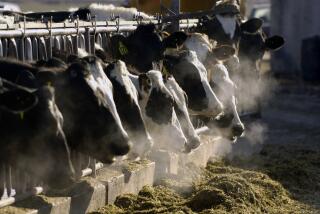New H5N1 bird flu variant found in Nevada dairy worker as new data show changes in virus

- Share via
- CNN reports a Nevada dairy worker may have been infected by deadly D1.1 version of H5N1 bird flu
- Worker shows only mild symptoms
- Genetic analyses of this version show changes that could make it pass more easily between people
A dairy worker in Nevada may have tested positive for a strain of H5N1 bird flu known to have killed one person and severely sickened another.
CNN reported Saturday night that a worker tested positive for the D1.1 version of the H5N1 bird flu virus. Confirmation testing by the Centers for Disease Control and Prevention is underway.
The report has not been confirmed by the CDC or Nevada’s Department of Health and Human Services.
According to CNN, the person’s symptoms include conjunctivitis, or pink eye — a common symptom that has been seen in people who have been exposed to the virus in North America since March 2024, when the virus was first reported in Texas dairy herds.
Since that time, 67 people have been infected with H5N1 bird flu. In 63 of those cases, workers picked up the virus while working with infected animals; 40 got it working with dairy cattle, 23 with infected poultry. In three cases, the source of exposure was not determined. And in one case, a person got it from handling sick and or dead birds in a backyard flock. That person died.
Last week, federal health officials announced that at least four dairy herds in Nevada had been infected by a strain of the H5N1 bird flu that is circulating in wild birds and that led to the death of one person in Louisiana and several sickened a teenager in Canada. That strain is called D1.1, and it is slightly different than the one that had been circulating widely in the nation’s dairy herds, which is called B3.13.
The news comes on the heels of a U.S. Department of Agriculture report that examined the D1.1 strain found in the Nevada dairy cows and found changes in the genetic code thought to help the virus copy itself more easily in mammals, including humans.
Researchers have not been able to determine how the wild bird version of the virus spilled into Nevada herds, although there were reports of massive bird die-offs in the area during that period.
Jennifer Nuzzo, director of the Pandemic Center at the Brown University School of Public Health, said if confirmed, it’s a relief this latest dairy worker is reported to have only shown mild symptoms, but she underscored how little we actually know about who gets sick and why when it comes to H5N1 bird flu.
She said there are several hypotheses floating around about why most dairy workers have, thus far, only shown mild symptoms after infection when compared to the severe cases reported in two people who had been exposed to D1.1. (Several poultry workers in Washington were also exposed to D1.1 while depopulating an infected poultry operation. While many had respiratory symptoms, they were considered mild cases by public health officials.)
One of those theories is that the H5N1 B3.13 version is less dangerous than D1.1, she said.
“I’ve not been convinced of that,” she said.
Now seeing someone having milder infection with D 1.1, “I think, just raises more questions about why some people have severe illness and why some people don’t,” she said. “I would argue that at this point, we have no idea ... and we shouldn’t assume that just because someone was exposed to one variant or another means they’re going to have mild or severe illness. ... We shouldn’t assume that H5N1 is in any way destined to be a mild virus. And for that reason, we need to treat each infection with caution and work to prevent future infections.”
Asked if she was surprised that roughly one year into the outbreak of H5N1 bird flu in dairy cattle people are still getting sick and infected, she said “no.”
Little has been done to increase the protection of dairy workers against this virus, she said, and health officials have not “done much to try to stay ahead of how this virus is transmitting and where.”
John Korslund, a former USDA scientist, agreed, and said in an email that his biggest concern about the news of a worker possibly being infected “is that the story had to be leaked - i.e. reporting to CNN was unauthorized. Why??”
He said recent comments from the Nevada State Agriculture Commissioner about “workers” with conjunctivitis suggested multiple cases, but there was no information about how many workers have been tested, he said. Nor have there been any official reports about clinical illness in the infected dairy herds, he said — although media reports have described the symptoms as respiratory.
The USDA highlighted in its report the National Milk Testing Strategy — a new program operating in 40 states, including Nevada, that requires testing of all raw milk destined for pasteurization — as a major contributor to the virus’s discovery in Nevada dairy herds.
According to the agency’s report on the herds in Nevada, samples collected on Jan. 6 and Jan. 7 tested positive, triggering an investigation by Nevada state officials to trace the source. On Jan. 17, regulatory officials collected samples from suspected dairies and submitted them to the Washington Animal Disease Diagnostic Laboratory, a USDA-approved lab. On Jan. 31, whole genome sequencing of the virus from affected farms indicated the strain was D1.1.
“Clinical signs were not observed in the cattle prior to the detection, but have been reported since,” wrote agency officials in the report.
“This virus is getting a shot at infecting a lot more people with much improved genomic adaptations! Risks have grown greatly,” said Korslund in an email. “Our best options are to isolate, sequence, and analyze as rapidly as possible as we develop a new ‘Warp Speed’ human and animal vaccination and therapeutics effort. OMB [the U.S. Office of Management and Budget] needs to take its foot off the throats of our saviors.”
More to Read
Sign up for Essential California
The most important California stories and recommendations in your inbox every morning.
You may occasionally receive promotional content from the Los Angeles Times.











